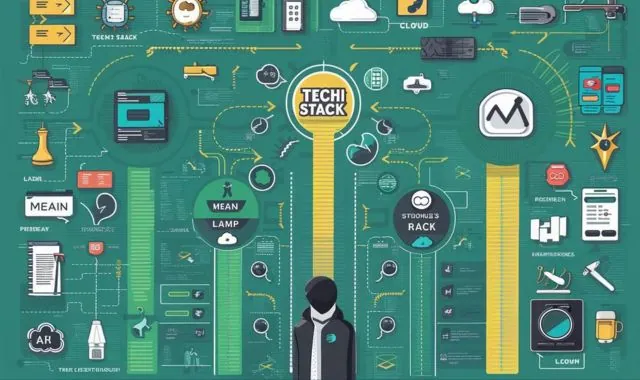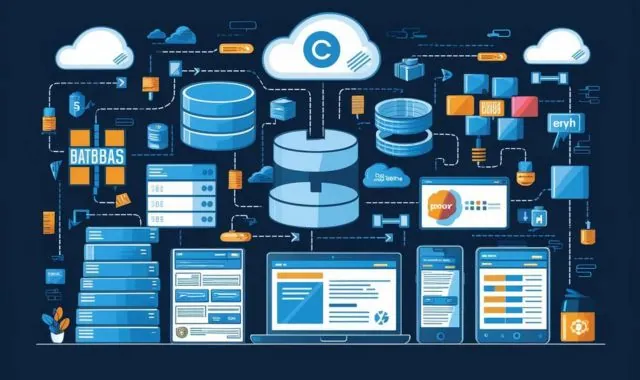Physical Address
304 North Cardinal St.
Dorchester Center, MA 02124

The tech stack is the foundation of websites and apps. It combines front-end (visuals) and back-end (engine) technologies like HTML, CSS, JavaScript, programming languages, databases, and APIs. Choosing the right tech stack depends on your project and can include popular options like MEAN or LAMP. The future holds exciting trends like cloud and AI integration. Explore and build your digital dreams with the right tech stack!

Have you ever wondered what goes on behind the scenes of your favorite websites and apps? It’s all thanks to something called a tech stack! This article will be your guide to understanding this essential concept in the digital world.
Imagine a delicious sandwich. The fluffy bread represents the front-end, the visible part of the website or app that you interact with. The fillings and sauces are the back-end, the hidden machinery that makes everything work. A tech stack is similar.
This is what you see and interact with – the buttons you click, the text you read, and the animations you watch.
This is the behind-the-scenes magic. It handles data storage, server communication, and complex calculations to deliver the functionalities you experience.
The front-end is the bread – it presents the information. The back-end is the filling – it provides the functionality. Together, they create a delicious (and functional) website or app!
Now that you understand the layers, let’s meet the key players:
Think of it as the skeleton of your website. It defines the structure and content layout.
Just like frosting on a cake, CSS adds visual design elements like colors, fonts, and layouts.
This is where things get interactive! JavaScript adds animations, user input functionality, and dynamic elements.
These are the instructions that tell the computer what to do. Popular back-end languages include Python, Java, and Ruby.
Imagine pre-made Lego sets for programmers. Frameworks provide pre-written code structures that save time and effort when building complex applications.
This is where all the website’s data is stored, like user information, product details, and blog posts. There are two main types: SQL databases for structured data and NoSQL databases for more flexible data formats.
APIs (Application Programming Interfaces) act as messengers, allowing different parts of the tech stack to communicate with each other and external services.
There’s no one-size-fits-all tech stack. The best choice depends on your project’s specific needs.
What do you want your website or app to achieve? Different functionalities require different tech stacks.
Choose a stack that aligns with your developers’ skills and experience for efficient development.
Consider how your project might grow in the future. Choose a stack that can handle increased user traffic and data.

A modern powerhouse combining MongoDB (database), Express.js (framework), Angular (front-end framework), and Node.js (back-end runtime environment).
A classic and reliable choice using Linux (operating system), Apache (web server), MySQL (database), and PHP (programming language).
The tech landscape is constantly evolving. Here are some exciting trends to watch:
Cloud platforms provide on-demand access to computing resources, making development faster and more scalable.
AI and ML are being incorporated into tech stacks to create smarter and more personalized user experiences.
Let’s delve a bit deeper into each component to understand their roles and functionalities better.
Explore frameworks like React or Vue.js, popular choices for building interactive user interfaces. Discuss preprocessors like SASS or LESS that can streamline CSS coding.
Provide a brief overview of different back-end frameworks like Django (Python) or Ruby on Rails (Ruby) to showcase their functionalities.
Expand on the concept of data modeling, explaining how data is structured within databases. Briefly touch upon cloud-based databases like Firebase for a glimpse into modern trends.
Offer some real-world examples of APIs, such as weather data APIs or social media APIs, to illustrate their practical applications.
Showcase how popular tech stacks are used in real-world applications:
Explain how Netflix might leverage the MEAN stack for its streaming platform, with MongoDB storing user data, Express.js handling server-side logic, Angular powering the user interface, and Node.js enabling real-time features.
Illustrate how a popular blogging platform like WordPress could utilize the LAMP stack, with Linux as the operating system, Apache serving web pages, MySQL storing blog posts and comments, and PHP powering dynamic functionalities.
Include a brief case study highlighting how a company’s choice of tech stack has contributed to its success. This could be a story about a startup that achieved rapid growth due to the scalability of its chosen stack or an established company that revamped its tech stack to improve performance.
Provide a sneak peek into advanced tech stack concepts that are shaping the future:
Briefly explain how microservices break down complex applications into smaller, independent services, making them more scalable and manageable.
Touch upon the concept of DevOps, which emphasizes collaboration between development and operations teams, leading to faster development cycles and smoother deployments.

The tech stack is no longer a mysterious realm for the tech-savvy alone. By understanding its components and exploring the possibilities, anyone can embark on building their digital dreams. Whether you’re a budding entrepreneur, a curious learner, or someone looking to enhance your existing skillset, the world of tech stacks offers a rewarding path.
Remember, the perfect tech stack is a journey, not a destination. As you explore different tools and delve deeper into their functionalities, you’ll gain the confidence to choose the right technology for your needs. Embrace the constant evolution of the tech landscape, stay curious, and don’t be afraid to experiment. There’s a whole world of possibilities waiting to be unlocked with the right tech stack as your foundation.
Here are some commonly asked questions about tech stacks to quench your curiosity:
A: Absolutely! The tech landscape is evolving rapidly, and there are now many low-code/no-code development platforms available. These platforms offer drag-and-drop interfaces and pre-built functionalities that allow you to create websites and applications without extensive coding knowledge.
A: While choosing the right tech stack is important, it’s not always a permanent decision. In the early stages of a project, you might have more flexibility to switch stacks if needed. However, changing a tech stack later in development can be complex and time-consuming. That’s why careful planning and considering factors like scalability from the beginning are crucial.
A: There’s a wealth of information available online! Here are some suggestions:
Most popular tech stacks have comprehensive documentation websites that explain their components, functionalities, and best practices.
Many online forums and communities are dedicated to specific tech stacks. Join these communities to connect with other developers, ask questions, and learn from their experiences.
Keep up-to-date with the latest trends and advancements by reading tech blogs and articles focused on specific tech stacks.
A: Yes, there are several advantages to learning a widely-used tech stack:
Many companies rely on popular tech stacks for their development needs. Having expertise in a sought-after stack can make you a more attractive candidate in the job market.
Popular tech stacks often have a wealth of learning resources available, from online tutorials to video courses.
When you learn a popular tech stack, you tap into a vast community of developers for support, collaboration, and knowledge sharing.